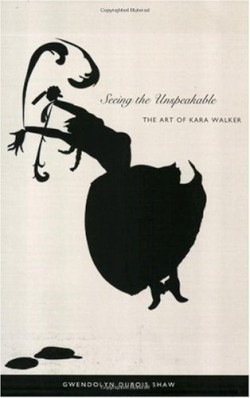Seeing the Unspeakable
The Art of Kara Walker
The title of this book about contemporary artist Kara Walker is reminiscent of Nobel Laureate Toni Morrison’s essay, “Unspeakable Things Unspoken: The Afro-American Presence in American Literature,” which first appeared in Michigan Quarterly Review in 1989. Morrison’s essay and Walker’s art both challenge notions of race and representation and the controversy that surrounds the two. Whereas Morrison concentrates on reading the unspeakable, the focus of this book is on seeing it in Walker’s paintings and cut-paper silhouettes.
The author is a professor of history of art and architecture and of African and American studies at Harvard University and co-editor of the upcoming Encyclopedia of African American Art and Architecture. In this extension of her doctoral dissertation, she provides details about Walker’s life and analyzes her work in all of its complexity.
Walker first gained notoriety in the 1990s when her fifty-foot-long silhouette, Gone: An Historical Romance of a Civil War as it Occurred Between the Dusky Thighs of One Young Negress and Her Heart, appeared at the Drawing Center in New York. In this volume, the reproductions of art by Walker—and others whom the author uses to contextualize Walker’s work—appear blurry at times and difficult to read. However, Shaw’s “reading” of them is intriguing and seemingly flawless.
Walker’s art is deeply influenced by literature, so that it acts as a type of narrative—a neo-slave narrative that allows Walker to expose what traditional slave narratives dared not. This re-memory, another term made popular by Morrison, is at the center of Morrison’s novel Beloved. As the novel does, Walker’s work makes the reader aware of occurrences during slavery often left unspoken by writers of slave narratives because of their link to race and sex. This tension is seen clearly in Walker’s The End of Uncle Tom and the Grand Allegorical Tableau of Eva in Heaven (1995), a large silhouette that signifies upon Stowe’s Uncle Tom’s Cabin (1852). The silhouette consists of four shocking scenes including one in which a slave child defecates while three slave women nurse at each other’s breasts. In another scene, a slave man appears to be in prayer as a baby dangles from his anus.
Other chapters provide an extensive analysis of several other provocative and disturbing works by Walker: John Brown (1996), A Means to an End: A Shadow Drama in Five Acts (1995), and Walker’s self-portrait, a silhouette titled Cut (1998). Despite controversy and severe criticism, including Detroit Institute of Arts’ refusal to exhibit her work, Walker is an A-list artist, receiving lucrative earnings for her talent. She has also been recognized with numerous honors, most notably the MacArthur “Genius” grant.
Those interested in art history and issues of race and representation will surely find this book rewarding, but possibly unsettling.
Reviewed by
Kaavonia Hinton
Disclosure: This article is not an endorsement, but a review. The publisher of this book provided free copies of the book to have their book reviewed by a professional reviewer. No fee was paid by the publisher for this review. Foreword Reviews only recommends books that we love. Foreword Magazine, Inc. is disclosing this in accordance with the Federal Trade Commission’s 16 CFR, Part 255.

